- Hotline: 852+ 2891 9689
- Whatsapp: 852+ 9146 8426
- [email protected]
- 6/F 29 Austin Road, Tsimshatsui, Kowloon, Hong Kong
One of the most damaging consequences of unregulated, low-cost hair transplant services — especially in black market settings — is donor depletion. The donor area, typically the back and sides of the scalp, contains a limited number of permanent hair follicles.
Once extracted, these follicles do not regenerate. In black market clinics, procedures are often performed by untrained personnel who focus on harvesting large numbers of grafts in a single session, regardless of long-term planning or medical safety. This leads to overharvesting, high transection rates, and visible scarring, leaving patients with patchy, thin donor zones that can no longer be used for future transplants.
Unfortunately, once the donor supply is exhausted or damaged, even a skilled surgeon may have no way to reverse the harm.

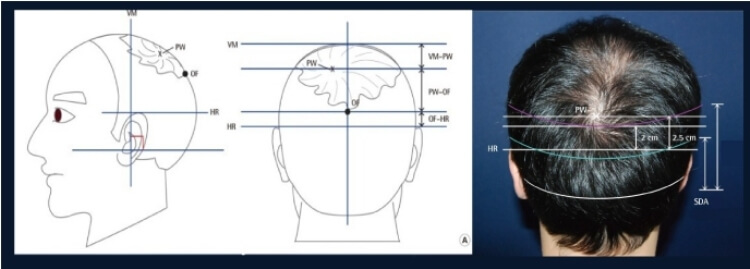
Reference
1. J.H.Pak, et al. Predicting the Permanent Safe Donor Area for Hair Transplantation in Koreans with Male Pattern Baldness according to the Position of the Parietal Whorl. Arch Plast Surg. 2014 May; 41(3): 277–284.
Donor supply is the ultimate limiting factor in hair transplantation for male pattern baldness (MPB) patients. According to Norwood’s Classification, a man with advance Class VII balding would still have a rim of hairs at the sides and back of the head.
This is labelled as the “Safe Donor Area” that is expected to be permanently covered with hair for a lifetime and therefore, provide permanent coverage when transplanted to the recipient area.
Hair transplant surgeons have been trying to transplant the maximum-possible number of hair grafts in a single session to cover more of the recipient area.
Many surgeons have frequently been in dispute about the appropriate standards for defining a safe donor area.
FUE and ARTAS are known to require a much larger donor area when compared to Strip/FUT. It has been a great concern that some hair transplant surgeon chose to ignore this Safe Donor Zone when desperate for the number of grafts. This obviously viloates the true purpose of hair transplant.


Many investors believe hair transplant is a quick way of making money. Centers are set up all over the world and doctors without proper training are assigned to take the follicles out and put them back, without caring about the result. Consequently we are seeing more and more clients with unsatisfactory results, such as scarring and hair grafts that are not growing. This has become a global problem.
The ISHRS has designated November 11th every year as “World Hair Transplant Repair Day” as a way of helping patients who have had a botched hair transplant surgery by unqualified doctors or black market clinics. As an ISHRS Fellow Member we are part of this mission.
Age is not a limiting factor — you are never too old for a hair transplant as long as you have a sufficient supply of healthy donor hair.
In fact, older patients often make excellent candidates because:
Whether you’re in your 50s, 60s, or beyond, what matters most is your overall health, donor hair availability, and your goals. Dr. Ng will assess all of these during your consultation to determine if you’re a good candidate.
Dr. Norman Orentreich, an American dermatologist, in his 1952 introduced the concept of “donor dominance,” laying the groundwork for contemporary hair restoration techniques. Its later publication in 1959 has contributed to the emergence of a multibillion-dollar global hair transplant industry, offering lasting solutions for receding hairlines and firmly establishing hair transplant as a significant aspect of American culture. The followings are the updated scientific principles:
Traditionally, scalp hair was classified into two categories: DHT-sensitive and DHT-insensitive. However, clinical experience suggests a more accurate classification involves three distinct types, each with different characteristics and responses to treatment:
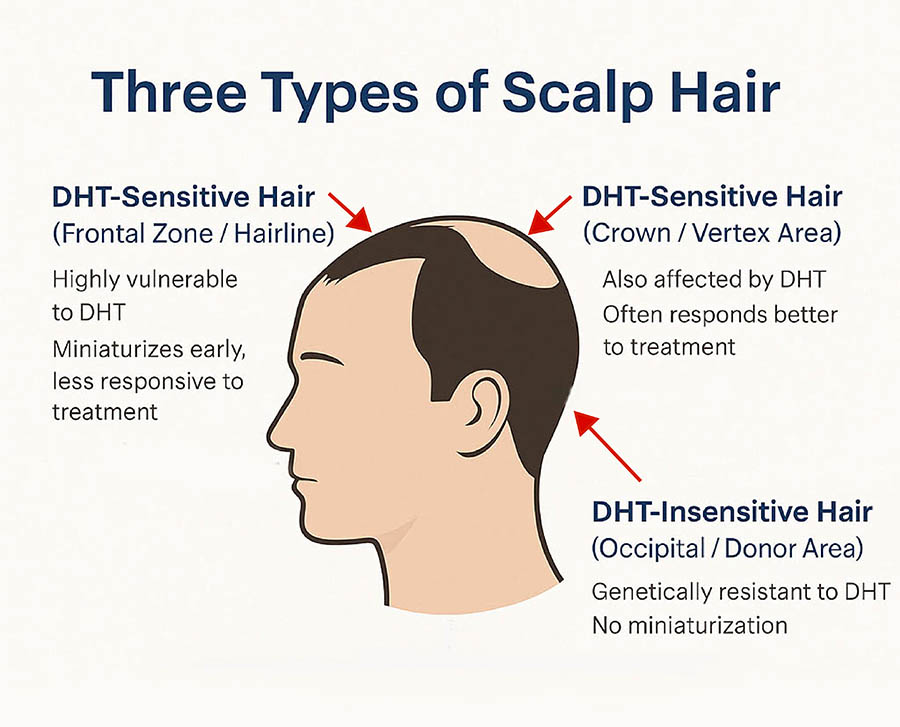
The cornerstone of modern hair transplantation has long been the Donor Dominance Theory. This principle holds that transplanted hair retains the characteristics of the donor site — such as color, curl, growth rate, and most importantly, resistance to DHT — even after relocation. This explains why there is no rejection, and why hair transplantation works so reliably.
However, advancements in the field have revealed a new layer to this understanding.
In the 2000s, Dr. Tommy Hwang (Korea) introduced the Recipient Dominance Theory. He observed that the recipient site can influence the behavior of the transplanted hair. For instance, scalp hair transplanted to the eyebrow tends to grow more slowly over time, gradually adopting the characteristics of the new location.
This breakthrough earned Dr. Hwang the ISHRS Gold Follicle Award, and reshaped how surgeons approach transplant planning — recognizing that both donor and recipient factors matter.
Regardless of the technique—FUT, FUE, or ARTAS robotic harvesting—every hair transplant procedure follows the same three core steps. The main difference lies in Step 2: how the donor hair is harvested.
Local Anesthesia
The scalp is numbed to ensure a pain-free experience during the procedure.
Donor Harvesting
Permanent hair is removed from the donor area, typically the back or sides of the scalp.
In FUT, a thin strip of scalp is excised and dissected.
In FUE, individual follicular units are extracted directly from the scalp.
In ARTAS, a robotic system performs automated follicle extraction.
Graft Insertion
Using high-powered magnification, harvested grafts—each containing 1 to 4 hairs—are carefully implanted into the thinning or bald areas. Each graft is placed at the correct angle, direction, and spacing to preserve existing follicles and ensure natural-looking results.
Thanks to the use of tiny follicular unit grafts, today’s hair transplants produce soft, natural hairlines—a dramatic improvement over the unnatural “pluggy” results of older methods. At our clinic, we strategically combine single-hair grafts (for natural hairlines) and multi-hair grafts (for visual density) to achieve the most refined aesthetic outcome possible.
Age is not a limiting factor — you are never too old for a hair transplant as long as you have a sufficient supply of healthy donor hair.
In fact, older patients often make excellent candidates because:
Whether you’re in your 50s, 60s, or beyond, what matters most is your overall health, donor hair availability, and your goals. Dr. Ng will assess all of these during your consultation to determine if you’re a good candidate.
Dr. Norman Orentreich, an American dermatologist, in his 1952 introduced the concept of “donor dominance,” laying the groundwork for contemporary hair restoration techniques. Its later publication in 1959 has contributed to the emergence of a multibillion-dollar global hair transplant industry, offering lasting solutions for receding hairlines and firmly establishing hair transplant as a significant aspect of American culture. The followings are the updated scientific principles:
Traditionally, scalp hair was classified into two categories: DHT-sensitive and DHT-insensitive. However, clinical experience suggests a more accurate classification involves three distinct types, each with different characteristics and responses to treatment:

The cornerstone of modern hair transplantation has long been the Donor Dominance Theory. This principle holds that transplanted hair retains the characteristics of the donor site — such as color, curl, growth rate, and most importantly, resistance to DHT — even after relocation. This explains why there is no rejection, and why hair transplantation works so reliably.
However, advancements in the field have revealed a new layer to this understanding.
In the 2000s, Dr. Tommy Hwang (Korea) introduced the Recipient Dominance Theory. He observed that the recipient site can influence the behavior of the transplanted hair. For instance, scalp hair transplanted to the eyebrow tends to grow more slowly over time, gradually adopting the characteristics of the new location.
This breakthrough earned Dr. Hwang the ISHRS Gold Follicle Award, and reshaped how surgeons approach transplant planning — recognizing that both donor and recipient factors matter.
Regardless of the technique—FUT, FUE, or ARTAS robotic harvesting—every hair transplant procedure follows the same three core steps. The main difference lies in Step 2: how the donor hair is harvested.
Local Anesthesia
The scalp is numbed to ensure a pain-free experience during the procedure.
Donor Harvesting
Permanent hair is removed from the donor area, typically the back or sides of the scalp.
In FUT, a thin strip of scalp is excised and dissected.
In FUE, individual follicular units are extracted directly from the scalp.
In ARTAS, a robotic system performs automated follicle extraction.
Graft Insertion
Using high-powered magnification, harvested grafts—each containing 1 to 4 hairs—are carefully implanted into the thinning or bald areas. Each graft is placed at the correct angle, direction, and spacing to preserve existing follicles and ensure natural-looking results.
Thanks to the use of tiny follicular unit grafts, today’s hair transplants produce soft, natural hairlines—a dramatic improvement over the unnatural “pluggy” results of older methods. At our clinic, we strategically combine single-hair grafts (for natural hairlines) and multi-hair grafts (for visual density) to achieve the most refined aesthetic outcome possible.
Age is not a limiting factor — you are never too old for a hair transplant as long as you have a sufficient supply of healthy donor hair.
In fact, older patients often make excellent candidates because:
Whether you’re in your 50s, 60s, or beyond, what matters most is your overall health, donor hair availability, and your goals. Dr. Ng will assess all of these during your consultation to determine if you’re a good candidate.
Dr. Norman Orentreich, an American dermatologist, in his 1952 introduced the concept of “donor dominance,” laying the groundwork for contemporary hair restoration techniques. Its later publication in 1959 has contributed to the emergence of a multibillion-dollar global hair transplant industry, offering lasting solutions for receding hairlines and firmly establishing hair transplant as a significant aspect of American culture. The followings are the updated scientific principles:
Traditionally, scalp hair was classified into two categories: DHT-sensitive and DHT-insensitive. However, clinical experience suggests a more accurate classification involves three distinct types, each with different characteristics and responses to treatment:

The cornerstone of modern hair transplantation has long been the Donor Dominance Theory. This principle holds that transplanted hair retains the characteristics of the donor site — such as color, curl, growth rate, and most importantly, resistance to DHT — even after relocation. This explains why there is no rejection, and why hair transplantation works so reliably.
However, advancements in the field have revealed a new layer to this understanding.
In the 2000s, Dr. Tommy Hwang (Korea) introduced the Recipient Dominance Theory. He observed that the recipient site can influence the behavior of the transplanted hair. For instance, scalp hair transplanted to the eyebrow tends to grow more slowly over time, gradually adopting the characteristics of the new location.
This breakthrough earned Dr. Hwang the ISHRS Gold Follicle Award, and reshaped how surgeons approach transplant planning — recognizing that both donor and recipient factors matter.
Regardless of the technique—FUT, FUE, or ARTAS robotic harvesting—every hair transplant procedure follows the same three core steps. The main difference lies in Step 2: how the donor hair is harvested.
Local Anesthesia
The scalp is numbed to ensure a pain-free experience during the procedure.
Donor Harvesting
Permanent hair is removed from the donor area, typically the back or sides of the scalp.
In FUT, a thin strip of scalp is excised and dissected.
In FUE, individual follicular units are extracted directly from the scalp.
In ARTAS, a robotic system performs automated follicle extraction.
Graft Insertion
Using high-powered magnification, harvested grafts—each containing 1 to 4 hairs—are carefully implanted into the thinning or bald areas. Each graft is placed at the correct angle, direction, and spacing to preserve existing follicles and ensure natural-looking results.
Thanks to the use of tiny follicular unit grafts, today’s hair transplants produce soft, natural hairlines—a dramatic improvement over the unnatural “pluggy” results of older methods. At our clinic, we strategically combine single-hair grafts (for natural hairlines) and multi-hair grafts (for visual density) to achieve the most refined aesthetic outcome possible.
All skin surgery including FUE produce scar. Welcome to compare our FUE -HD donor scars.
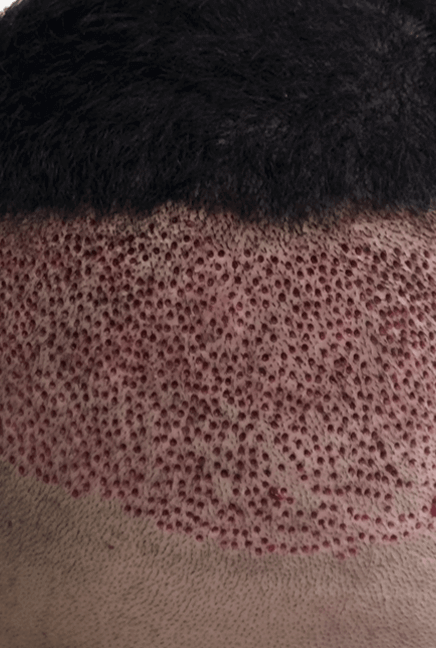
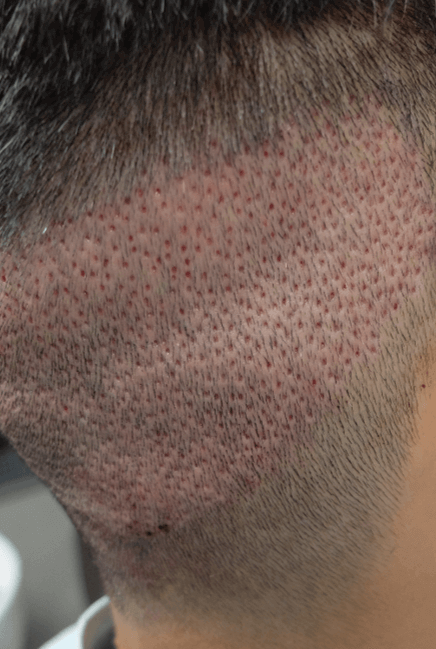
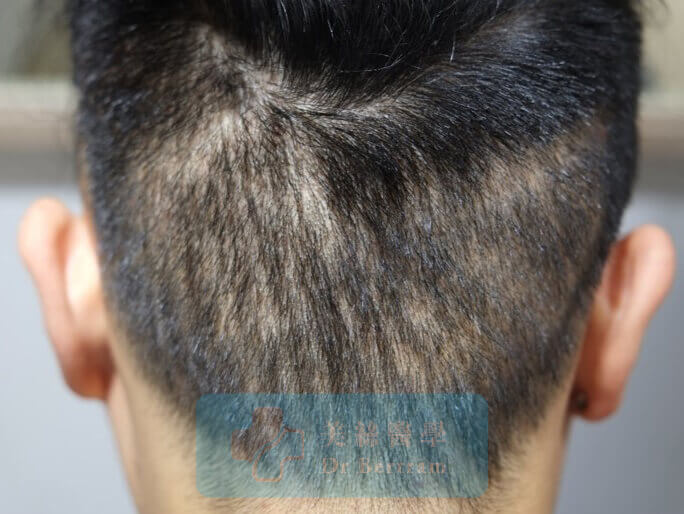


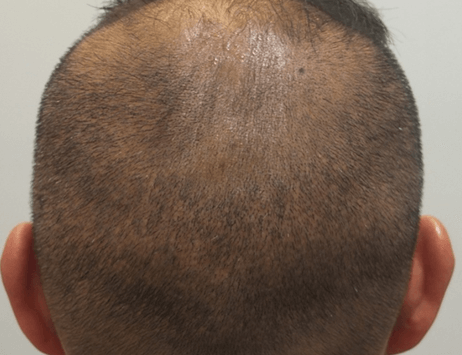

One of the most damaging consequences of unregulated, low-cost hair transplant services — especially in black market settings — is donor depletion. The donor area, typically the back and sides of the scalp, contains a limited number of permanent hair follicles.
Once extracted, these follicles do not regenerate. In black market clinics, procedures are often performed by untrained personnel who focus on harvesting large numbers of grafts in a single session, regardless of long-term planning or medical safety. This leads to overharvesting, high transection rates, and visible scarring, leaving patients with patchy, thin donor zones that can no longer be used for future transplants.
Unfortunately, once the donor supply is exhausted or damaged, even a skilled surgeon may have no way to reverse the harm.

Choosing a reputable medical clinic with experienced doctors is not just about achieving good results — it’s about protecting your only source of grafts for life.

From consultation, surgery, to aftercare, you will receive continued personal care by our doctors, not just consultants.
Have a question? Please feel free to call our friendly customer service.
International Accreditations
Accredited by leading international medical organizations, we are the most qualified hair transplant center in Hong Kong and mainland China you can trust.
Hair transplant is the ultimate solution to restores hair, but not everyone is good candidate.
Our online assessment helps determine if these procedures suit you, saving you time and costs.